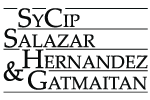Philippine Chapter of Getting the Deal Through: Vertical Agreements 2018
April, 2018 - Arlene Maneja, Franco Aristotle Larcina
Philippines
Franco Aristotle G. Larcina and Arlene M. Maneja
SyCip Salazar Hernandez & Gatmaitan
Antitrust Law
1. What are the legal sources that set out the antitrust law applicable to vertical restraints?
The key statute is Republic Act No. 10667, otherwise known as the Philippine Competition Act (PCA), which was enacted on 21 July 2015 and which became effective on 8 August 2015. In respect of vertical restraints, the PCA is implemented primarily by the Rules and Regulations to Implement the Provisions of Republic Act No. 10667 (Philippine Competition Act) (IRR) and the Rules of Procedure of the Philippine Competition Commission (Rules), both of which were promulgated by the Philippine Competition Commission (PCC).
However, in respect of the PCA's effectivity against anticompetitive agreements (including vertical restraints) that were pre-existing prior to its effectivity, the PCA provided for a two-year grace period starting from the date of its effectivity on 8 August 2015, during which parties to such agreements were not exposed to the penalties provided under the act, as long as they corrected such agreement to be compliant with the PCA during said two-year period. That two-year period ended on 8 August 2017.
Thus, there is very little, if any, precedent or local enforcement history in respect of vertical restraints.
It is significant to note, however, that the PCA has borrowed from foreign sources, and following precedents on similar laws, the PCC and local courts may be inclined to consider foreign laws, precedents and best practices on vertical restraints as having at least a persuasive effect.
Types of vertical restraint
2. List and describe the types of vertical restraints that are subject to antitrust law. Is the concept of vertical restraint defined in the antitrust law?
The PCA prohibits all agreements 'which have the object or effect of substantially preventing, restricting or lessening competition' (PCA, section 14)c)). In addition, the PCA enumerates the following as prohibited acts constituting abuse of dominant position (subject to certain specific exemptions):
- selling goods or services below cost with the object of driving competition out of the relevant market;
- imposing barriers to entry or committing acts that prevent competitors from growing within the market in an anticompetitive manner;
- making a transaction subject to acceptance by the other parties of other obligations which, by their nature or according to commercial usage, have no connection with the transaction;
- setting prices or other terms or conditions that discriminate unreasonably between customers or sellers of the same goods or services, where such customers or sellers are contemporaneously trading on similar terms and conditions, where the effect may be to lessen competition substantially;
- imposing restrictions on the lease or contract for sale or trade of goods or services concerning where, to whom, or in what forms goods or services may be sold or traded, such as: (i) fixing prices, or (ii) giving preferential discounts or rebate upon such price, or (iii) imposing conditions not to deal with competing entities; where the object or effect of the restrictions is to prevent, restrict or lessen competition substantially;
- making supply of particular goods or services dependent upon the purchase of other goods or services from the supplier which have no direct connection with the main goods or services to be supplied;
- directly or indirectly imposing unfairly low purchase prices for the goods or services of, among others, marginalised agricultural producers, fisherfolk, micro-, small-, medium-scaled enterprises, and other marginalised service providers and producers;
- directly or indirectly imposing unfair purchase or selling price on their competitors, custsomers, suppliers, or consumers; and
- limiting production, markets, or technical development to the prejudice of consumers.
(PCA, section 15)
The term 'vertical restraints; is not expressly defined under the laws and regulations.
Legal objective
3. Is the only objective pursued by the law on vertical restraints economic, or does it also seek to promote or protect other interests?
The PCC has not issued any guidelines specific to vertical restraints that expressly set ou tthe policies and objectives pursued by prohibitions on vertical restraints. The immediate objective of the PCA is to promote free and fair competition. However, a reading of the various provisions of the law, as well as various pronouncements of the PCC, reveals an underlying objective of consumer protection (achieved by ensuring competition in the marketplace). Certain provisions also highlight an intent to protect small business, such as the express prohibition against abuse of dominant position by imposing unfairly low purchase prices for the goods or services of, among others, marginalised agricultural producers, fisherfolk, micro-, small- and medium-scale enterprises, and other marginalised service providers and producers.
Visit the SyCipLaw website to download a copy of the full Philippine chapter of Getting the Deal Through: Vertical Agreements.
Link to article


 Post a comment
Post a comment Print article
Print article

